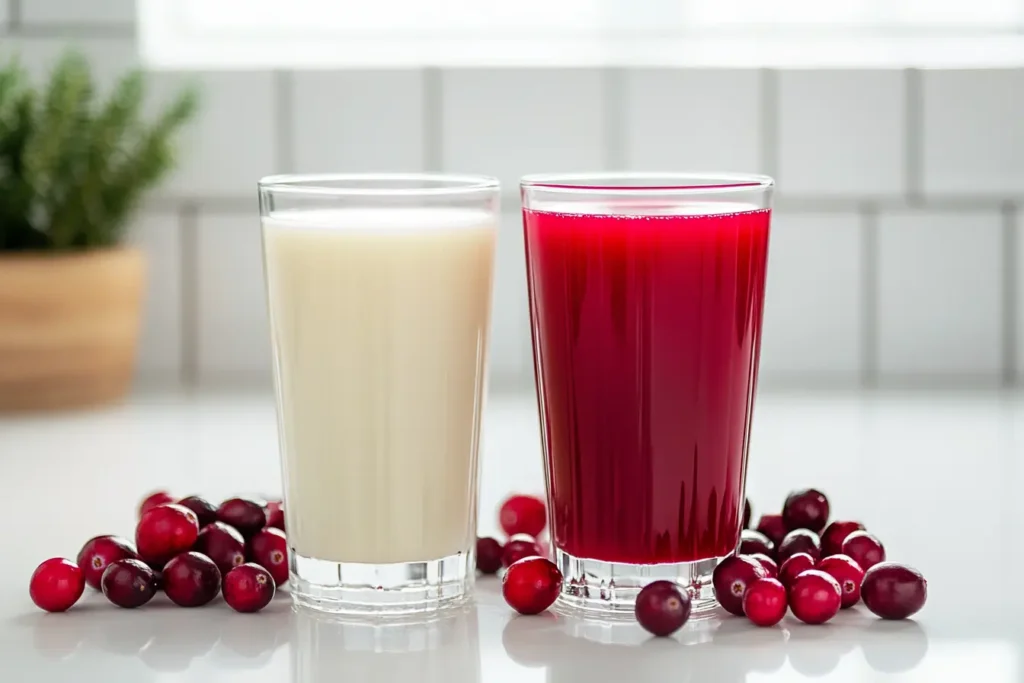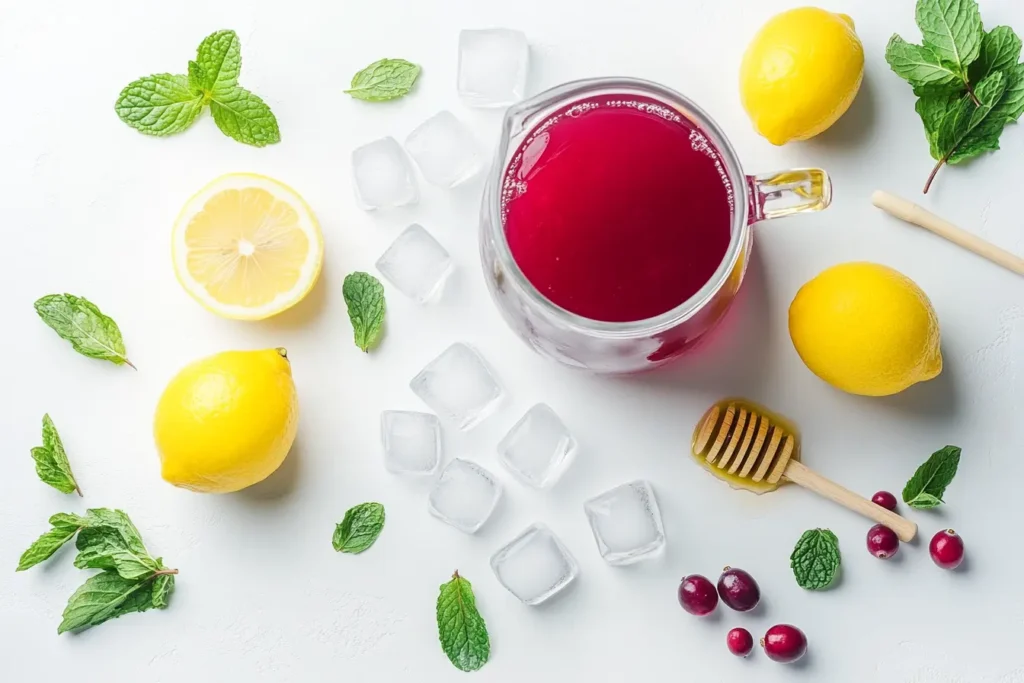White cranberry juice has piqued the curiosity of many due to its delicate taste and versatility. While red cranberry juice is known for its tartness, white cranberry juice offers a unique alternative, boasting a milder profile. This article explores the origin, flavor, uses, and benefits of this juice in detail. By the end, you’ll have a comprehensive understanding of what makes white cranberry juice a refreshing choice.
Introduction to White Cranberry Juice
What Is White Cranberry Juice?
White cranberry juice comes from cranberries harvested early, before they ripen into their deep red color. These young berries create a juice that tastes mild, slightly sweet, and less tart than red cranberry juice. Its pale, clear color adds to its appeal. Many prefer it because it feels lighter and gentler on the palate.
Origin and Production of White Cranberry Juice
Cranberries, native to North America, grow in wet, marshy areas. Farmers pick the berries early to make white cranberry juice. This early harvest prevents the berries from becoming too tart. After picking, the berries are pressed for juice and processed to keep their natural sweetness.
White cranberry juice gained popularity in the late 20th century. Brands like Ocean Spray introduced it as a softer, sweeter alternative. Today, its unique taste and versatility make it a favorite for many.
Nutritional Profile of White Cranberry Juice
White cranberry juice is rich in vitamin C and vitamin E, which boost the immune system and improve skin health. It also has fewer sugars than some other fruit juices, making it a healthier choice for those watching calories.
Although its antioxidant levels are lower than red cranberry juice, it still provides a good source of hydration and nutrients. It’s an excellent option for those who prefer a lighter taste without compromising health benefits.
Flavor Profile of White Cranberry Juice
Taste Comparison: White vs. Red Cranberry Juice

White cranberry juice offers a milder, more subtle flavor compared to the bold tartness of red cranberry juice. While red cranberry juice is often described as sharp and tangy, white cranberry juice feels smoother, with a hint of natural sweetness. This difference comes from the ripeness of the berries.
Cranberries used for red juice are fully ripened, which gives them a more pronounced acidity. White cranberries, harvested earlier, have not yet developed these intense tart compounds. For those who find red cranberry juice too overpowering, white cranberry juice provides a gentler alternative. It works well as a base in beverages, appealing to those who enjoy lighter fruit flavors.
Factors Influencing the Taste of White Cranberry Juice
The flavor of white cranberry juice depends on several factors:
- Harvest Time: Earlier harvesting ensures the berries are less acidic, resulting in a sweeter juice.
- Processing Methods: Gentle processing helps preserve the mild and delicate flavor of white cranberries.
- Blend and Additives: Some brands enhance their juice with sweeteners or natural flavors, which can alter its taste.
The growing conditions also play a role. Cranberries cultivated in cooler climates tend to have a more refined flavor profile, which affects the final juice taste.
Consumer Descriptions of White Cranberry Juice Flavor
People often describe white cranberry juice as refreshing, light, and less biting compared to its red counterpart. Many consumers highlight its fruity notes, saying it tastes crisp and clean, similar to a diluted apple or pear juice.
Some say its subtle sweetness makes it ideal for sensitive palates. Others enjoy it as a versatile mixer in drinks or as a standalone refreshment. It appeals to those who prefer a juice that isn’t overly sweet or sour.
White Cranberry Juice Recipe: Refreshing Citrus Cooler

Ingredients
- 2 cups white cranberry juice
- 1 cup cold water
- 1 tablespoon lemon juice
- 1 tablespoon honey (optional for sweetness)
- Ice cubes
- Mint leaves for garnish (optional)
Step-by-Step Instructions
- Prepare the Base: In a large pitcher, mix white cranberry juice, cold water, and lemon juice. Stir well to combine the flavors.
- Add Sweetness (Optional): If you prefer a sweeter drink, stir in honey until it dissolves completely.
- Chill: Add ice cubes directly into the pitcher or pour the mixture over ice in individual glasses.
- Garnish: Add a sprig of mint to each glass for a refreshing touch.
- Serve and Enjoy: Serve immediately for the best flavor.
This simple recipe enhances the natural sweetness of white cranberry juice while adding a citrusy twist. It’s perfect for warm days or as a healthy alternative to sugary drinks.
Nutritional Content of White Cranberry Juice (Per 100g)
| Nutrient | Amount |
|---|---|
| Calories | 45 kcal |
| Carbohydrates | 11g |
| Sugars | 10g |
| Vitamin C | 4mg |
| Calcium | 3mg |
| Iron | 0.1mg |
Culinary Uses of White Cranberry Juice
White Cranberry Juice in Beverages and Mocktails
White cranberry juice is an incredibly versatile base for light and refreshing drinks. Because of its mild sweetness, it pairs well with many fruit juices, making it a popular choice for spritzers, punches, and mocktails. For instance, when mixed with sparkling water, it creates a crisp, bubbly drink that’s both simple and satisfying.
Not only does white cranberry juice blend seamlessly with citrus flavors like lime or orange, but it also complements berries and tropical fruits. You can use it in non-alcoholic sangrias with slices of orange, apple, and grapes for a fruity twist. Moreover, adding a handful of crushed mint leaves or a splash of lemon juice enhances its refreshing quality.
For a festive touch, white cranberry juice spritzers with a hint of ginger and a garnish of lime zest can elevate any gathering. Its light profile ensures it doesn’t overshadow other ingredients, making it a perfect mixer for creative beverage recipes.
Cooking and Baking with White Cranberry Juice
White cranberry juice isn’t just for drinking; it’s also a fantastic ingredient in cooking and baking. Because of its gentle sweetness, it works well in marinades, especially for chicken and turkey, where it adds a subtle fruity flavor. Additionally, its slight tartness balances well in glazes for roasted vegetables or meat.
In baking, white cranberry juice can replace water or milk in recipes like muffins, pancakes, or cakes to bring a fruity hint. For instance, adding it to a vanilla cake batter introduces a delicate sweetness that enhances the overall flavor. Furthermore, white cranberry juice can be reduced to create a syrup for drizzling over desserts like cheesecake or ice cream.
One simple idea is to make a sorbet by mixing white cranberry juice with sugar and freezing it. Not only is it refreshing, but it’s also an easy way to showcase the juice’s natural taste.
Pairing White Cranberry Juice with Foods
White cranberry juice pairs beautifully with a wide variety of dishes. On the savory side, it complements soft cheeses like brie or camembert, while its slight tartness balances the richness of creamy pasta dishes. Additionally, it works wonderfully with white meats like chicken or turkey and seafood such as salmon or shrimp.
For salads, white cranberry juice adds a zesty note when paired with ingredients like goat cheese, walnuts, and citrus fruits. On the other hand, it’s also a delightful match for desserts. Cakes, tarts, and vanilla-based treats benefit from its mild sweetness, which enhances rather than overpowers the flavors.
In short, whether you’re planning a light meal, a rich entrée, or a sweet finish, white cranberry juice adapts easily, bringing a refreshing balance to almost any dish.
Part 4: Health Benefits and Considerations
Antioxidant Properties of White Cranberry Juice
White cranberry juice contains antioxidants, which help protect the body from harmful free radicals. While it has fewer polyphenols and flavonoids compared to red cranberry juice, it still offers a decent amount of these compounds. Antioxidants support overall health by reducing oxidative stress, which may contribute to aging and chronic diseases.
Additionally, white cranberry juice contains vitamin C and E, both of which act as powerful antioxidants. These vitamins not only boost the immune system but also promote healthy skin and tissues. For people looking for a lighter juice with some health benefits, white cranberry juice is a good option. However, its antioxidant levels might be slightly lower because it is made from unripe berries.
When consumed as part of a balanced diet, white cranberry juice can contribute to better health and provide a refreshing way to stay hydrated.
White Cranberry Juice and Urinary Tract Health
Cranberry juice, including the white variety, has long been associated with urinary tract health. It contains compounds called proanthocyanidins (PACs), which can prevent certain bacteria from sticking to the urinary tract walls. This property may help reduce the risk of urinary tract infections (UTIs).
Although white cranberry juice has lower PAC levels compared to red cranberry juice, it can still offer mild support for urinary health. Drinking it regularly, along with plenty of water, may help maintain a healthy urinary system. However, individuals prone to recurrent UTIs may find red cranberry juice more effective due to its higher concentration of active compounds.
It’s always important to consult a healthcare provider for serious or recurring health issues. Incorporating white cranberry juice into your routine can complement other preventive measures for better urinary health.
Potential Side Effects and Precautions
While white cranberry juice is generally safe, there are a few precautions to consider. Drinking large amounts may lead to digestive discomfort, such as bloating or diarrhea, especially for those sensitive to fruit juices. The natural sugars in white cranberry juice, while less than in some other juices, can still contribute to calorie intake if consumed excessively.
For individuals managing blood sugar levels, choosing a version without added sugars is essential. Furthermore, some brands may include additives or preservatives, which can affect people with sensitivities or allergies. Always check the label for ingredients to ensure you’re consuming a pure product.
Lastly, white cranberry juice may interact with certain medications, such as blood thinners, similar to red cranberry juice. It’s wise to discuss any potential interactions with your healthcare provider before adding it to your diet regularly.
Frequently Asked Questions
Is white cranberry juice less tart than red cranberry juice?
Yes, white cranberry juice is less tart compared to red cranberry juice. The primary reason lies in the ripeness of the berries. White cranberry juice is made from berries harvested early, before they develop the full acidity of ripe cranberries. As a result, it has a smoother, milder taste that many describe as lightly sweet with a gentle tang.
For those who find red cranberry juice too sharp, white cranberry juice provides a softer alternative. It’s especially appealing for people who prefer a more subtle flavor profile in their beverages.
Can white cranberry juice be used as a substitute for red cranberry juice in recipes?
Yes, white cranberry juice can be used as a substitute for red cranberry juice in many recipes, though it may slightly alter the taste. Because it’s less tart, recipes may require an adjustment, such as adding a splash of lemon juice or vinegar to achieve a similar tang.
In sweet dishes, white cranberry juice can enhance the flavors without being overpowering. For example, it works well in desserts, dressings, and marinades where a softer flavor is desired. While it’s not a perfect match in every case, it’s a versatile alternative that works in most recipes.
Does white cranberry juice have the same health benefits as red cranberry juice?
White cranberry juice offers many of the same benefits as red cranberry juice, though some differences exist. Both juices are rich in vitamins C and E, which support the immune system and skin health. However, white cranberry juice has lower levels of proanthocyanidins and antioxidants due to its earlier harvest.
For urinary tract health, red cranberry juice may have a slight edge due to its higher concentration of active compounds. Nevertheless, white cranberry juice still provides hydration and moderate health benefits, making it a suitable option for those who prefer its milder taste.
How is white cranberry juice made?
White cranberry juice is made by harvesting cranberries before they fully ripen. The early-picked berries are pale in color and have a milder flavor. After harvesting, the berries are washed, pressed, and processed into juice.
To preserve its delicate taste, manufacturers use gentle processing methods. This helps retain its natural sweetness and clear appearance. Some brands may enhance the flavor by blending it with other natural juices or adding a small amount of sugar.
Is white cranberry juice suitable for children?
Yes, white cranberry juice is suitable for children. Its mild taste makes it more appealing to young palates compared to the tartness of red cranberry juice. Moreover, it provides hydration and essential nutrients like vitamin C, which supports immune health.
However, it’s essential to choose versions without added sugars or artificial additives. Diluting the juice with water is also a good idea for younger children, as it reduces the sugar concentration while still providing a refreshing drink.
Where can I purchase White Cranberry Juice Taste Like?
White cranberry juice is available in most grocery stores and online retailers. It’s commonly found in the juice aisle, often alongside other cranberry juice varieties. Brands like Ocean Spray and store-label alternatives frequently offer white cranberry juice.
If it’s not available locally, online platforms like Amazon or specialty food stores are excellent options. Make sure to read product descriptions and reviews to ensure you’re purchasing a pure and high-quality version of the juice.

